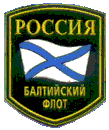






 The Baltic Fleet is headquartered in Kaliningrad, where it is defended by a naval infantry brigade. From this rather exposed location, the fleet controls naval bases at Kronshtadt and Baltiysk. The breakup of the Soviet Union deprived the Baltic Fleet of key bases in Latvia, Lithuania, and Estonia, leaving Kaliningrad Oblast as the Fleet's only ice-free naval outlet to the Baltic Sea. Kaliningrad Oblast is the headquarters of the Russian Navy's Baltic Fleet and the site of one of its two main naval bases in the region, Baltiisk. Armed forces comparable in size to the entire Polish army are stationed in Kaliningrad Oblast, which is a Russian enclave completely cut off from the rest of Russia by Poland and Lithuania. Developments in Russia's federal system in recent years have resulted in some areas gaining considerable autonomy, in particular Kaliningrad, where the Jantar Free Economic Zone has been set up. The other major Baltic Fleet base is at Kronstadt, a satellite-town of St.Petersburg located at the Kotlin island in the Gulf of Finland, some 29 km NW of St. Petersburg. The island is about 12 km long with a maximum width of 2 km, and the Navy base of the Russian Baltic Fleet occupies about one half of the island.
The Baltic Fleet is headquartered in Kaliningrad, where it is defended by a naval infantry brigade. From this rather exposed location, the fleet controls naval bases at Kronshtadt and Baltiysk. The breakup of the Soviet Union deprived the Baltic Fleet of key bases in Latvia, Lithuania, and Estonia, leaving Kaliningrad Oblast as the Fleet's only ice-free naval outlet to the Baltic Sea. Kaliningrad Oblast is the headquarters of the Russian Navy's Baltic Fleet and the site of one of its two main naval bases in the region, Baltiisk. Armed forces comparable in size to the entire Polish army are stationed in Kaliningrad Oblast, which is a Russian enclave completely cut off from the rest of Russia by Poland and Lithuania. Developments in Russia's federal system in recent years have resulted in some areas gaining considerable autonomy, in particular Kaliningrad, where the Jantar Free Economic Zone has been set up. The other major Baltic Fleet base is at Kronstadt, a satellite-town of St.Petersburg located at the Kotlin island in the Gulf of Finland, some 29 km NW of St. Petersburg. The island is about 12 km long with a maximum width of 2 km, and the Navy base of the Russian Baltic Fleet occupies about one half of the island.
As of 1996 operational forces included nine submarines, twenty-three principal surface combatants [three cruisers, two destroyers, and eighteen frigates], and approximately sixty-five smaller vessels. The Baltic Fleet included one brigade of naval infantry and two regiments of coastal defense artillery. The air arm of the Baltic Fleet included 195 combat aircraft organized into five regiments and a number of other fixed-wing aircraft and helicopters. The Baltic Fleet does not include any strategic-missile submarines, but as of mid-1997 it included 32 major surface combatants (3 cruisers, 3 destroyers, and 26 frigates), more than 230 other surface vessels, roughly 200 naval aircraft, 9 tactical submarines, and a brigade of naval infantry. As of mid-2000 the Baltic Fleet included about 100 combat ships of various types, and the Fleet's Sea Aviation Group units were equipped with a total of 112 aircraft.
In the late 1990s the incorporation of air defense units into the Baltic Fleet structure was the first step in reforming the Baltic Fleet. Another step was the creation of the Fleet's coastal and ground forces based on the Baltic Fleet units and the 11th Guards General-Purpose Army that is located in the Kaliningrad region. The Fleet's artillery, rocket, coastal units and a marine brigade, and ground force's units were consolidated into a completely new structure, the Fleet's ground and coastal troops. As of mid-2000 this group consists of the Moscow-Minsk Proletarian Division, a Marine Brigade, Coastal Rocket Units and a number of bases at which arms and equipment are kept.In the immediate postwar period, the Soviet Union established a formidable, closed enclave in the former East Prussia, including a large naval port at Kaliningrad (formerly K�nigsberg). When the Soviet Union collapsed, the independence of Estonia, Latvia, and Lithuania deprived the new Russian state of major ports on the Baltic Sea, and 15,000-square-kilometer Kaliningrad Oblast between Poland and Lithuania was cut off from Russia. When Russia insisted on maintaining Kaliningrad as a heavily armed garrison, it aroused considerable international criticism, especially from Poland. K�nigsberg was awarded to the Soviet Union under the Potsdam Accord in 1945, but the Russian Federation holds no legal title to the enclave.
When Russia withdrew all its former Warsaw Pact forces from Poland and the Baltic states during 1992-94, some air, naval, and ground forces were relocated to Kaliningrad, ostensibly because of housing shortages elsewhere in Russia. In mid-1996 the official military garrison was estimated at 24,000 ground troops of the 11th Guards Combined Arms Army, including one tank division and three motorized rifle divisions, three artillery brigades, surface-to-surface and surface-to-air missiles, and attack helicopters.
As of 1996 Western experts estimated that the total Kaliningrad garrison includes as many as 200,000 military personnel, compared with the official Russian figure of 100,000. In 1993 the population of the enclave was about 900,000, of whom about 700,000 were Russians. There was strong sentiment in favor of autonomy among the civilian population, and international pressure continued to advocate reducing the garrison to a level of "reasonable sufficiency," far below its current size. Some Russian military authorities agreed with this idea because maintaining the Kaliningrad force was extremely expensive. However, a large-scale deemphasis of the military would be difficult because the entire oblast has been structured to meet the needs of the armed forces. In addition, Russian nationalists argue that Kaliningrad is a vital outpost at a time when Russia is menaced by Polish or even Lithuanian membership in NATO.
